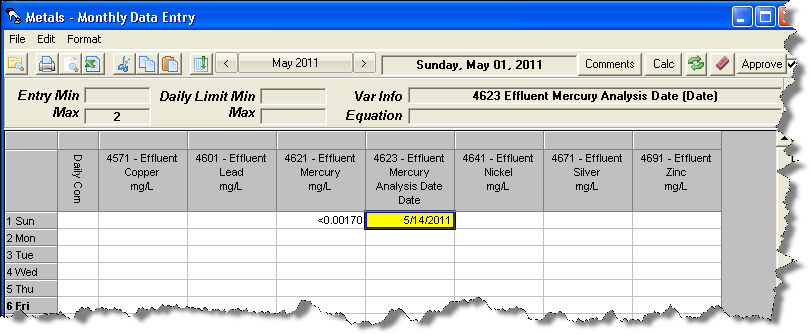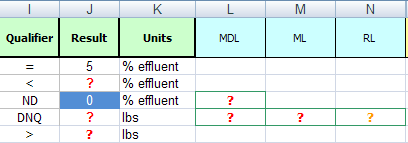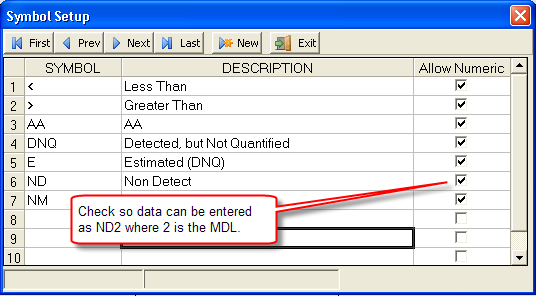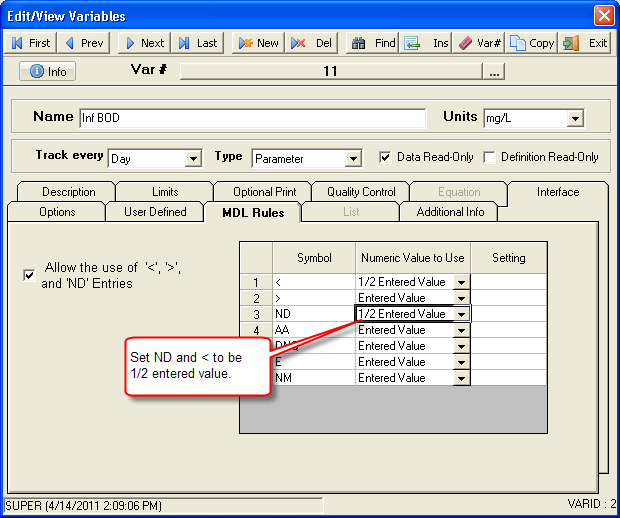Decide where to store result Metadata
In order to produce the California CIWQS electronic report, we must report certain "metadata" about a result such as Method, Sample Number, MDL, RL, etc... Therefore, we must decide how we are going to track this information in WIMS. We have the following basic options:
1. Use the WIMS add-on Lab Cal - easiest option as all the metadata is already captured using Lab Cal.
2. Use Data Additional Info fields - If you have a LIMS Interface the Data Additional Info fields can be populated by the interface from your LIMS making this option the best for users with LIMS Interfaces. If you don't have a LIMS this is still a good choice as it gives you a simple interface to enter your metadata by hand.
3. Use Variable User Defined Fields - Good choice for metadata that does not change such as RL, Method etc...
4. Create additional variables - Straight forward option, create a seperate variable for each parameter's metadata. For example, for Influent BOD create the following variables:
Influent SampleNum - Text Variable that holds the sample number for Inf BOD, Inf TSS, etc...
BOD MDL - Calculated variable using the LV function allowing you to Force the MDL in every time it changes.
BOD RL - Calculated variable using the LV function and Force to change. You may be able to use a Variable's User Defined field as the RL does not change often (once every couple of years as far as we understand).
5. Use constants in the report
What Metadata has to be tracked? Depending on your lab and local rules, not all metadata needs to be tracked. For example, if you do not have results with the DNQ qualifier, you do not need to track the ML/RL since it is only reported with DNQ results.
SampID - The sample id. Not required by the PET tool. If you are using Lab Cal or importing data from a LIMS it is not a bad idea to report the values. Otherwise you do not need to report it and can simply use the constant "N/A".
Analysis Date (ANADATE) - The date the analysis is complete (from CIWQS Help center, 1-866-79-CIWQS). Therefore, for many Parameters, this can be set to the Sample/Collect Date (i.e. I took the TSS today and analyzed it today), or add a number of days to the Sample Date (i.e. I took BOD today, started the analysis and it will be finished 5 days from now). Use the Days after Collection Date option in these cases. Otherwise, you will need to enter the Anaysis Date into Additional Info or a different variable. I.E. For Effluent Mercury (V4621), setup a text variable, Effluent Mercury Analysis Date (V4623). If you take a sample on May 1st and analyze it on May 14th, enter:

Method Detection Limit (MDL, CIWQS LABDL field) based on the ability of a measurement to detect an analyte in the absence of a matrix. The MDL only needs to be reported with ND and DNQ qualifiers. Depending on how often your MDL for an analyte changes will help determine how to track you MDL in WIMS.
- Changes rarely (less than once/year). Use a constant when locating, when the MDL changes, you will need to edit the report and change the constant.
- Changes often. Create a calculated variable, i.e. V5011 BOD MDL and use the formula LV(C5011,2,-1) and Force the value everytime it changes.
- If you have a LIMS interface and your LIMS can provide the MDL, import the MDL into a Data Additional Info Field.
ML (ML/RL, CIWQS REPDL field) is the minimum or reporting limit. WIMS populates the ML field as the PET tool allows you to enter either of the ML or RL if a DNQ result is reported. The ML is often state mandated, therefore using the constant is the most typical setup. However, if your ML/RL's change, use the same techniques as the MDL.

Calculations
Scenario: PET tool asks for Average Monthly (AMEL) BOD
What is the Average of <2, <2, and 10.
When using an ND or a < value in an average calculation, we are using a substitution of ½ of the MDL (or the < value) in the calculation. For the above example (1+1+10)/3 = 4. Therefore, you may want to setup your ND symbol to allow numeric entries and use the 1/2 entered value rule for ND. See Symbol Setup, Variable Setup - MDL Rules


Scenario: Calculating Averages with DNQs (i.e. What is the Average of <2, ND with an MDL 2, DNQ3, and 10):
We have received different answers depending on your regional board/permit:
Option 1. For the DNQ value, use the reported estimated value in the calculation, but the same rules apply to the ND and < values. (1+1+3+10)/4 = 3.75
Option 2. Use the GAVGMED spread function which sorts the values and reports the Median if a DNQ is found, otherwise it calculates the average.
Scenario: Calculating Loads
When calculating load, use the MDL * flow* 8.34, not 1/2 the MDL. For example: <2 mg/L * 1MGD * 8.34 = <16.7 (2 * 1 * 8.34). If you are using a different rule for < and ND, use the MDLV function to calc. MDLV(V4011,1) * V1 * 8.34. (Regional Board)